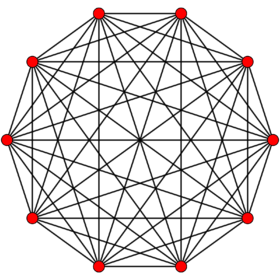9-simplex
| Regular decayotton (9-simplex) | |
|---|---|
 Orthogonal projection inside Petrie polygon | |
| Type | Regular 9-polytope |
| Family | simplex |
| Schläfli symbol | {3,3,3,3,3,3,3,3} |
| Coxeter-Dynkin diagram | |
| 8-faces | 10 8-simplex |
| 7-faces | 45 7-simplex |
| 6-faces | 120 6-simplex |
| 5-faces | 210 5-simplex |
| 4-faces | 252 5-cell |
| Cells | 210 tetrahedron |
| Faces | 120 triangle |
| Edges | 45 |
| Vertices | 10 |
| Vertex figure | 8-simplex |
| Petrie polygon | decagon |
| Coxeter group | A9 [3,3,3,3,3,3,3,3] |
| Dual | Self-dual |
| Properties | convex |
In geometry, a 9-simplex is a self-dual regular 9-polytope. It has 10 vertices, 45 edges, 120 triangle faces, 210 tetrahedral cells, 252 5-cell 4-faces, 210 5-simplex 5-faces, 120 6-simplex 6-faces, 45 7-simplex 7-faces, and 10 8-simplex 8-faces. Its dihedral angle is cos−1(1/9), or approximately 83.62°.
It can also be called a decayotton, or deca-9-tope, as a 10-facetted polytope in 9-dimensions.. The name decayotton is derived from deca for ten facets in Greek and yotta (a variation of "oct" for eight), having 8-dimensional facets, and -on.
Coordinates
The Cartesian coordinates of the vertices of an origin-centered regular decayotton having edge length 2 are:
- [math]\displaystyle{ \left(\sqrt{1/45},\ 1/6,\ \sqrt{1/28},\ \sqrt{1/21},\ \sqrt{1/15},\ \sqrt{1/10},\ \sqrt{1/6},\ \sqrt{1/3},\ \pm1\right) }[/math]
- [math]\displaystyle{ \left(\sqrt{1/45},\ 1/6,\ \sqrt{1/28},\ \sqrt{1/21},\ \sqrt{1/15},\ \sqrt{1/10},\ \sqrt{1/6},\ -2\sqrt{1/3},\ 0\right) }[/math]
- [math]\displaystyle{ \left(\sqrt{1/45},\ 1/6,\ \sqrt{1/28},\ \sqrt{1/21},\ \sqrt{1/15},\ \sqrt{1/10},\ -\sqrt{3/2},\ 0,\ 0\right) }[/math]
- [math]\displaystyle{ \left(\sqrt{1/45},\ 1/6,\ \sqrt{1/28},\ \sqrt{1/21},\ \sqrt{1/15},\ -2\sqrt{2/5},\ 0,\ 0,\ 0\right) }[/math]
- [math]\displaystyle{ \left(\sqrt{1/45},\ 1/6,\ \sqrt{1/28},\ \sqrt{1/21},\ -\sqrt{5/3},\ 0,\ 0,\ 0,\ 0\right) }[/math]
- [math]\displaystyle{ \left(\sqrt{1/45},\ 1/6,\ \sqrt{1/28},\ -\sqrt{12/7},\ 0,\ 0,\ 0,\ 0,\ 0\right) }[/math]
- [math]\displaystyle{ \left(\sqrt{1/45},\ 1/6,\ -\sqrt{7/4},\ 0,\ 0,\ 0,\ 0,\ 0,\ 0\right) }[/math]
- [math]\displaystyle{ \left(\sqrt{1/45},\ -4/3,\ 0,\ 0,\ 0,\ 0,\ 0,\ 0,\ 0\right) }[/math]
- [math]\displaystyle{ \left(-3\sqrt{1/5},\ 0,\ 0,\ 0,\ 0,\ 0,\ 0,\ 0,\ 0\right) }[/math]
More simply, the vertices of the 9-simplex can be positioned in 10-space as permutations of (0,0,0,0,0,0,0,0,0,1). These are the vertices of one Facet of the 10-orthoplex.
Images
References
- Coxeter, H.S.M.:
- Sherk, F. Arthur; McMullen, Peter; Thompson, Anthony C. et al., eds (1995). Kaleidoscopes: Selected Writings of H.S.M. Coxeter. Wiley. ISBN 978-0-471-01003-6. https://books.google.com/books?id=fUm5Mwfx8rAC&pg=PP1.
- (Paper 22)
- (Paper 23)
- (Paper 24)
- (Paper 22)
- Conway, John H.; Burgiel, Heidi; Goodman-Strauss, Chaim (2008). "26. Hemicubes: 1n1". The Symmetries of Things. pp. 409. ISBN 978-1-56881-220-5.
- Johnson, Norman (1991), Uniform Polytopes
- Johnson, N.W. (1966). The Theory of Uniform Polytopes and Honeycombs (PhD). University of Toronto. OCLC 258527038.
- Klitzing, Richard. "9D uniform polytopes (polyyotta) x3o3o3o3o3o3o3o3o — day". https://bendwavy.org/klitzing/dimensions/polyyotta.htm.
External links
- Glossary for hyperspace, George Olshevsky.
- Polytopes of Various Dimensions
- Multi-dimensional Glossary
Fundamental convex regular and uniform polytopes in dimensions 2–10
| ||||||||||||
|---|---|---|---|---|---|---|---|---|---|---|---|---|
| Family | An | Bn | I2(p) / Dn | E6 / E7 / E8 / F4 / G2 | Hn | |||||||
| Regular polygon | Triangle | Square | p-gon | Hexagon | Pentagon | |||||||
| Uniform polyhedron | Tetrahedron | Octahedron • Cube | Demicube | Dodecahedron • Icosahedron | ||||||||
| Uniform 4-polytope | 5-cell | 16-cell • Tesseract | Demitesseract | 24-cell | 120-cell • 600-cell | |||||||
| Uniform 5-polytope | 5-simplex | 5-orthoplex • 5-cube | 5-demicube | |||||||||
| Uniform 6-polytope | 6-simplex | 6-orthoplex • 6-cube | 6-demicube | 122 • 221 | ||||||||
| Uniform 7-polytope | 7-simplex | 7-orthoplex • 7-cube | 7-demicube | 132 • 231 • 321 | ||||||||
| Uniform 8-polytope | 8-simplex | 8-orthoplex • 8-cube | 8-demicube | 142 • 241 • 421 | ||||||||
| Uniform 9-polytope | 9-simplex | 9-orthoplex • 9-cube | 9-demicube | |||||||||
| Uniform 10-polytope | 10-simplex | 10-orthoplex • 10-cube | 10-demicube | |||||||||
| Uniform n-polytope | n-simplex | n-orthoplex • n-cube | n-demicube | 1k2 • 2k1 • k21 | n-pentagonal polytope | |||||||
| Topics: Polytope families • Regular polytope • List of regular polytopes and compounds | ||||||||||||
 |

